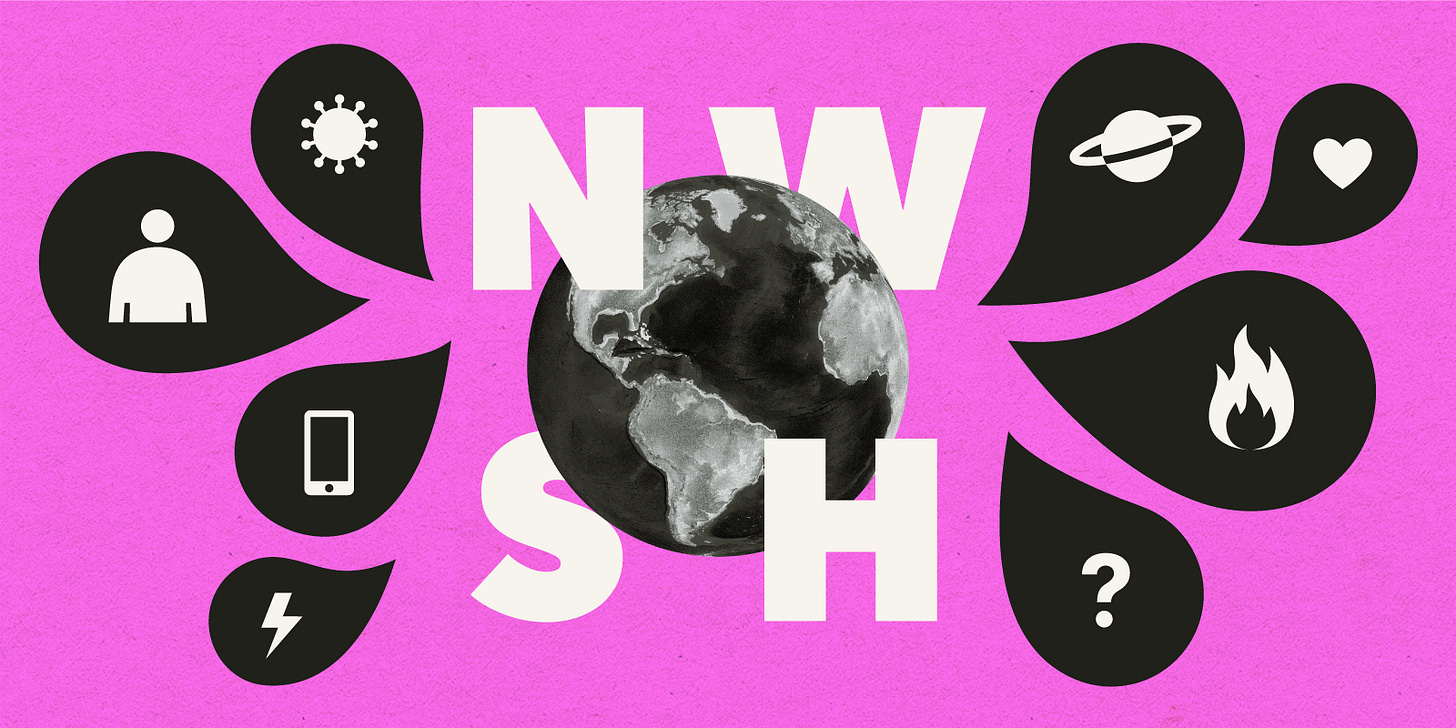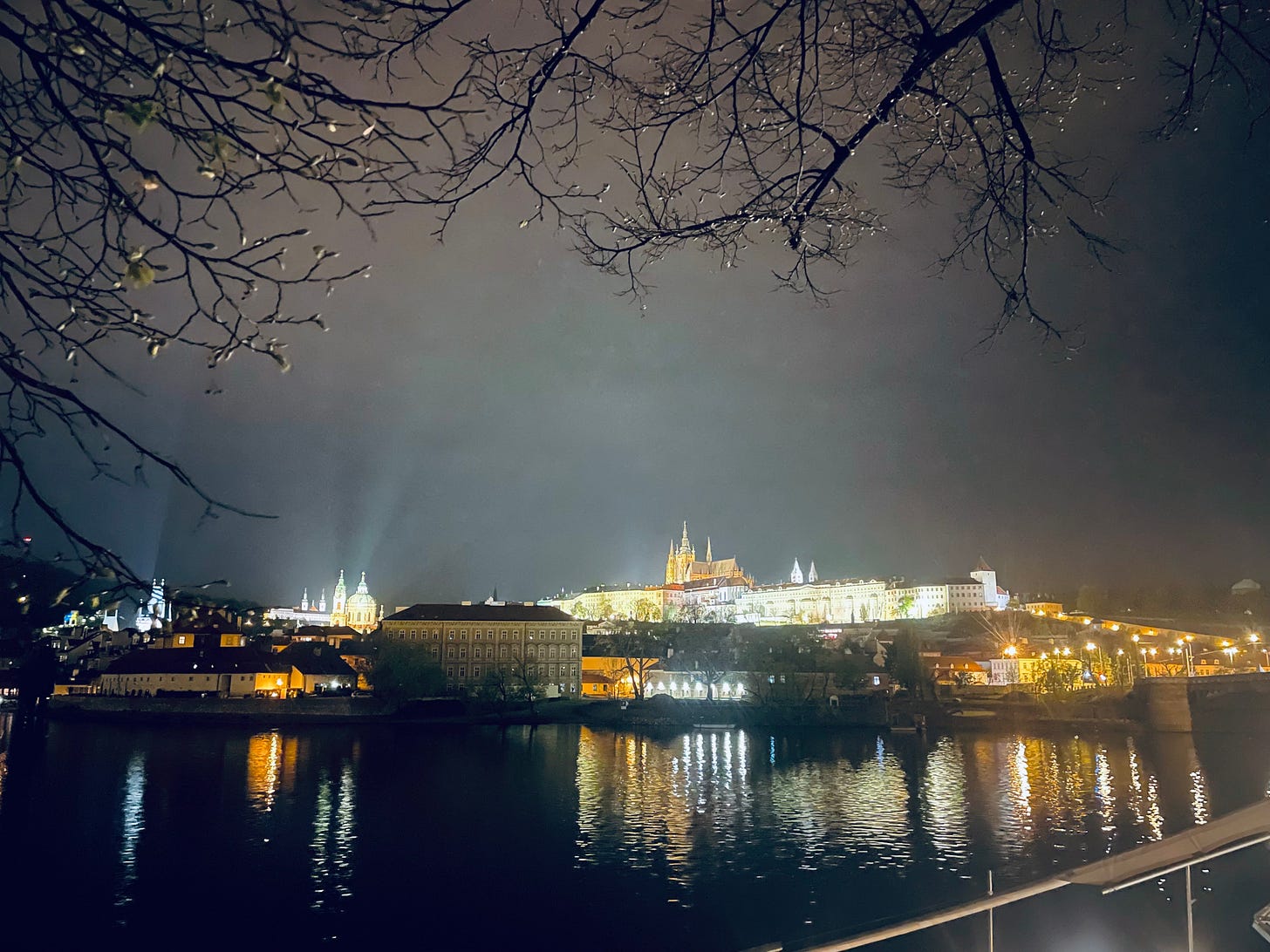New Week #80
The United Nations wants to cover the globe in floating cities. New research says Zoom calls kill creativity. Plus more news and analysis from this week.
Welcome to the mid-week update from New World Same Humans, a newsletter on trends, technology, and society by David Mattin.
If you’re reading this and haven’t yet subscribed, join 22,000+ curious souls on a journey to build a better future 🚀🔮
To Begin
I write to you, this week, from Prague. I’m here for a speaking engagement; talking about the metaverse — and the innovation opportunities it affords — to a multinational media and gaming organisation.
This week, the United Nations announced plans for the world’s first floating city off the coast of South Korea.
Meanwhile, the inventor of CRISPR gene editing says the technology could deliver a solution to climate change. And new research suggests that video calls inhibit creativity.
Let’s get into it.
🏙 City of dreams
At an event in New York this week, the United Nations unveiled its prototype for the world’s first floating city.
The hyper-futuristic Oceanix Busan will be built off the coast of the South Korean port city of Busan. It’s being developed via a partnership between the UN, maritime development firm Oceanix, and superstar Danish architect Bjarke Ingels.
This marks the first implementation of an ambitious long-term plan — led by Ingels and the UN — to build multiple floating cities around the world in order to mitigate the risks presented by rising sea levels. Check out this glossy video, released when the partnership was first announced:
Busan is South Korea’s second largest city; the shipping hub is home to 3.4 people.
The floating addition to the city will consist of modular, interconnected floating panels span 6.3 hectares: enough space for a community of 12,000. Eventually, the idea is to expand Oceanix Busan so it can be a home to hundreds of thousands.
Renewables, mainly solar, will provide 100% of the energy, and all water used on the island city will be treated and recycled.
⚡ NWSH Take: According to the UN, over 90% of megacities worldwide are vulnerable to rising sea levels. ‘We cannot continue building cities the way New York or Nairobi were built,’ says Deputy Secretary-General Amina Mohammed. Oceanix Busan is the first act in an audacious plan to address that truth, and reconfigure multiple cities across the globe. // If that plan succeeds, Bjarke Ingels will have a decent claim to be the most significant architect of the 21st-century. Ingels comes up time and again during my research for NWSH; his architecture firm, BIG, is behind other landmark projects in architectural futures, including Toyota’s planned ‘city of the future’, the hi-tech Woven City near Mount Fuji, and this Martian settlement commissioned by NASA for use in an upcoming simulated mission to the Red Planet. // Ingels isn’t without his critics, though. The key question: are his grandiose visions of a shiny, sustainable, hyper-technological future really the answer? Or should we, instead, seek out new modes of life that are smaller, more local, and less energy intensive? I’ll be addressing those questions, via more about Ingels, in a future essay.
🙌 Creator mode
I’ve written often, since the start of the pandemic, on the relationship between remote work and creativity.
The summary? Longstanding evidence suggests that team creativity and innovation depends on a constant flow of informal communication inside and between teams. But isn’t there a danger that this kind of chat is severely reduced, or dies off altogether, when colleagues work remotely?
A new paper in Nature lends credence to the idea that remote work and creativity aren’t a great match. Researchers at Columbia and Stanford studied 1,490 engineers working for a multinational company. The engineers were put into pairs and asked to brainstorm new product ideas. Those who worked together in-person generated more ideas, and more creative ideas as judged by an independent panel, than those who worked over video calls.
The researchers suggest that video calls limit access to creative prompts, such as objects in the environment. Instead they force participants to focus narrowly on their screens, and so inhibit associative thinking.
⚡ NWSH Take: Back in New Week #52 I wrote about a massive Microsoft study that came to similar conclusions. The researchers analysed email, calendar, messaging and call data from 60,000 staff and found that remote work caused teams to fall into isolated silos. // That study and this new paper are far from proof that remote work damages organisational innovation and creativity. But they’re troubling. And they align with what many of us feel intuitively: that the various kinds of spontaneous and tangential chat that fuels new ideas becomes less frequent when everyone works from home. // Remote and hybrid work aren’t going away. That means the race to address this challenge — to create what I’ve called a chit chat economy — will be one of the defining business stories of this decade. Expect a raft of new tools intended to fuel serendipitous meetings and informal conversations between colleagues. Meanwhile, at least one Silicon Valley titan is busy developing his vision of the long-term answer.
🧬 Edit button
The co-inventor of CRISPR gene editing, Professor Jennifer Doudna, gave a fascinating interview to the MIT Technology Review this week.
Unsurprisingly, there’s been much talk of CRISPR’s potential to spark a revolution in medicine in the coming years. But Doudna says it may have an even greater impact in another domain:
‘I suspect that over the next decade, when we think about global impact and impact on daily lives, that’s where the uses in agriculture and even to address climate change will potentially have a much broader impact. Pam Ronald, who is a professor at UC Davis … has been able to use CRISPR to engineer drought-tolerant rice and is in the process of field-testing these plants here, locally, in California. Something that’s farther out, but I think also potentially very high impact, is using CRISPR in microbial communities, in the soil or in water, that will allow us to enhance their capabilities for carbon capture.’
Doudna also says she doesn’t rule out the therapeutic use of CRISPR in human embryos; for example, to make genetic changes that will protect against Alzheimer’s.
⚡ NWSH Take: Multiple CRISPR-fuelled revolutions are speeding towards us. This month, researchers at Northwestern Medicine published news of their use of CRISPR techniques to identify the human genes involved in HIV infection. Last month, the FDA approved the first CRISPR edited cows for beef; the animals are engineered to make them resistant to the higher temperatures that are arriving due to climate change. // One reminder of the ethical war zones we’re going to have to navigate? He Jiankui, the Chinese scientist who shocked the world with this 2018 claim to have created the world’s first CRISPR edited babies, was recently released from prison. He’s team said they’d edited genes to render babies resistant to HIV infection — just the kind of use that Doudna, in this week’s interview, says may come to be seen as legitimate. At the time, He was widely condemned; including by his own government. Will he come to be seen as a CRISPR hero?
🗓️ Also this week
🤷♂️ Elon Musk may not buy Twitter after all, but basically no one knows anything. Some observers believe that tweets from Musk criticising the company’s management signal that he’s changing his mind about the acquisition. Tesla stock has fallen by more than a fifth since it was announced.
🧱 An AI developed by Meta has invented better concrete. The AI discovered a formula for a new kind of concrete that is stronger than the ordinary kind and uses 50% less carbon in its production. That’s a big deal; production of concrete accounts for around eight per cent of global CO2 emissions each year.
🥤 Meanwhile, a new enzyme engineered by an AI can break down plastic three times faster than similar enzymes. The enzyme works on PET, which is the kind of plastic used in bottles and textiles.
🌏 China wants to find another Earth. Chinese scientists will survey planets outside the Solar System in an attempt to find an Earth-like planet orbiting in the habitable zone of a star.
👨💻 A full 64% of workers say they’d consider quitting if asked to return to the office full time. That’s according to a new survey of 32,000 workers across 17 countries by the ADP Research Institute.
🌐 The US, EU and 32 other countries issued a new Declaration for the Future of the Internet. It lays out a vision of an ‘open, free, global, interoperable, reliable, and secure’ web. In New Week #73 I wrote about Putin’s plan to unplug Russia from the global internet.
🤖 The West Japan Rail Company is using massive, VR-controlled robots to fix its train lines. The company is currently trialing the robots, and hopes to have them in service by 2024.
🌍 Humans of Earth
Key metrics to help you keep track of Project Human.
🙋 Global population: 7,943,455,833
🌊 Earths currently needed: 1.8080701842
💉 Global population vaccinated: 59.0%
🗓️ 2022 progress bar: 32% complete
📖 On this day: On 29 April 1770 James Cook arrives in Australia and names his destination point Botany Bay.
Floating Point
Thanks for reading this week.
Can Bjarke Ingels and the UN transform the nature of our megacities in the 21st-century? New World Same Humans will keep watching.
In the meantime, I’ll leave you with a digital postcard; a picture taken on my midnight walk through Prague.
And remember, if this week’s instalment resonated with you there’s one thing you can do to help the NWSH community: share! Why not forward the email to someone who’d also enjoy it? Or share it across one of your social networks, with a note on why you found it valuable. The larger and more diverse the NWSH community becomes, the better for all of us.
I’ll be back next week. And I promise the next instalment of my VR essay, The Worlds to Come, is coming soon! Be well,
David.
P.S Huge thanks to Nikki Ritmeijer for the illustration at the top of this email. And to Monique van Dusseldorp for additional research and analysis.





